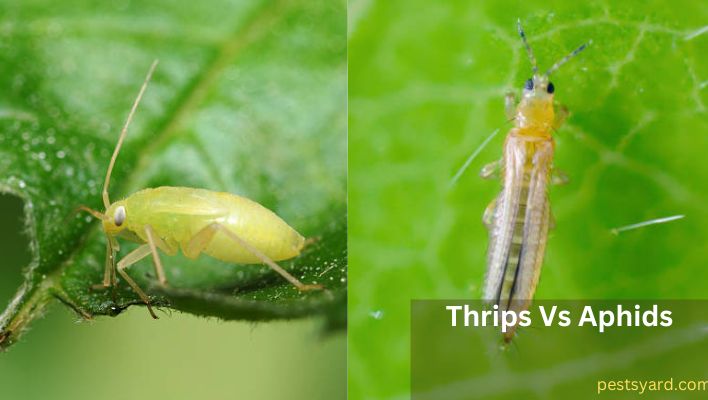When you think of aphids and thrips, you might immediately draw a connection to each other. As pests, both thrips and aphids can wreak havoc on your garden. However, as a gardener, knowing about these two insects is important to know what you are fighting and protecting your plants against.
While they might be two different pests, they can be extremely detrimental to your plants. If you own a garden, it is important to know the difference between them and how best to eliminate them.
Both thrips and aphids are small insects that feed on plants, causing damage to your plants and thus making it difficult for the plant to grow. Their only difference is that thrips have wings, whereas aphids do not. They both thrive well in greenhouses but have different habits depending on their environment.
Thrips can be a problem during the summer, particularly in warmer climates. Aphids are small insects that suck sap from plants and are often found in gardens. They are typically more of a problem during spring and fall.
There are many different species of aphids, but they all share certain traits that make them a threat to your plants. In this article, we’ll compare these two pests and see how to get rid of either one using natural means.
What are thrips
Thrips are tiny insects that grow to about 1/16 of an inch long. The thrips have six legs, a thin body, and long thin antennae. They are brown or black with white dots on them. The thrips have a sucking mouthpart called a rostrum that they use to suck justice from plants and other insects.
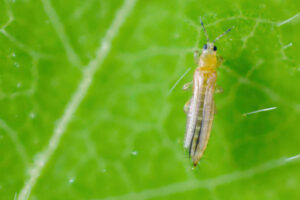
Thrips are often found on foliage but feed on the undersides of leaves and flower petals. They can cause the leaves of plants to turn yellow and fall off. They also carry disease-causing viruses like Potato Virus Y and Tomato Spotted Wilt Virus.
Thrips do not damage crops directly; instead, they cause damage by feeding on plants’ resources, such as water and nutrients. It can die when a plant’s resources are depleted by thrips feeding.
Thrips also transmit pathogens like viruses and bacteria that can infect humans through contact with infected plant materials, including dust from soil surfaces where thrips have been found living in large numbers or from contaminated mulch materials used as bedding for soils with poor drainage.
There are several kinds of thrip species out there as well; these insects eat plant leaves and stem at night while their hosts are asleep. While these insects don’t cause any real damage to your plants during the daytime hours when you’d expect them most often, they can cause problems later on when it’s dark.
What are aphids
Aphids are tiny insects, about 1/8 inch long, that suck the juices from plants. They can be found on all kinds of plants but are most common on roses and other flowering plants. Aphids are often confused with whitefly or mealybugs, but they’re two different kinds of insects.
They are sometimes called plant lice (not to be confused with true lice). They have six legs, three pairs of antennae, and a mouthpart called a stylet to pierce the leaf surface and suck out the sap.

Aphids tend to congregate in groups called colonies. The females can reproduce without mating; however, they need a male partner for fertilization.
The young aphid females will lay eggs in colonies close to where they hatched. The aphids will produce honeydew on their bodies, attracting ants who will protect their colony by feeding off the honeydew produced by aphids.
Aphids usually do not cause serious damage to your plants unless you have neglected them for a long period or apply pesticides late in their growing season.
Nonetheless, aphids can be a problem because they reproduce quickly. In addition to reproducing rapidly, they produce large numbers of offspring that can move from one plant to another easily.
Thrips vs aphids
There are many differences between thrips and aphids, including where they live and how they reproduce. However, both pests feed on plants similarly: sucking sap from their leaves. They also share some other traits, such as being attracted to color and having special antennae that help them sense changes in air temperature or humidity levels.
Thrips are tiny brown insects that can be found in many plants and in the soil, including flowers, vegetables, and trees; they don’t bite or sting people and don’t carry disease. Aphids are tiny insects that feed on plants and weaken them by sucking out the juice. Aphids can also transmit plant viruses. Below are the main difference between aphids and thrips
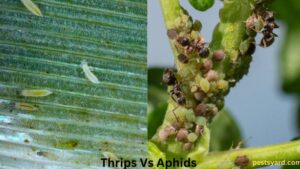
Difference between thrips and aphids
Thrips and aphids are two common pests that can decrease the output of your yield and sometimes cause your plants to wilt and die. They’re also pretty similar because aphids look like tiny green bugs, while thrips look like tiny black bugs. Below is the articulated difference between these two plants
- Aphids are soft-bodied insects that have a pear-like shape with a pointed tip. Their scientific name is Aphidius colemani. In contrast, thrips are small insects with wings (they resemble small flies). Their scientific name is Thrips tabaci.
- Thrips do not damage plants but rather suck the juices out of leaves, making them look dry and brown. Aphids suck the sap out of plants and feed on it, causing them to curl up and look sickly.
- Both are insects that feed on plants, but they do it in different ways. Aphids suck the juices from their host plant’s leaves, leaving behind a sticky mess (honeydew), which attracts ants, wasps, and other insects. In contrast, thrips feed on the juices and then excrete them as waste.
- Aphids tend to congregate around light sources like windows or screens to attract pollinators such as bees and wasps; thrips tend not to move around much, if at all.
- Aphids have a distinct smell when crushed underfoot; thrips do not have a distinct smell when crushed underfoot (although they can smell).
- Aphids tend to move in large groups, while thrips tend not to move in large groups unless they are young larvae still developing within their egg sacs.
- Aphids have round heads, while thrips have long snouts that can be used to pierce and feed on plants.
- Aphids typically reproduce by parthenogenesis; These eggs hatch into larvae that feed on plant juices. They leave their host plant when they mature and move on to another one. In contrast, thrips reproduce sexually by producing eggs that hatch into nymphs that feed on plant juices before moving on to another host plant.
Signs of Thrips
The presence of thrips in your greenhouse can be a serious problem, as they can cause damage to your plants and reduce their yield. They can be found in many plants, including fruit trees, vegetable gardens, and ornamental flowers.
Thrips have a small black head with three legs on each side. Their bodies are brown or black with red or yellow stripes running down their backs. You can identify thrips by looking for the following signs:
- The thrips can be seen on the underside of leaves or fruit, feeding on plant juices.
- Thrip damage that looks like small holes in the leaves
- Brown spots with yellow centers on the underside of leaves may be another sign of thrips infestation. In this case, you’ll see yellow or orange bands on the leaf surface between veins or veins themselves. This is caused by immature stages that haven’t yet left their host plant’s roots to begin life as an adult.
- Leaves look yellow and droopy or have white spots on them.
- When you touch the plant, it feels bumpy, like bumps are on the leaves.
- Your plant will start to wilt when infested by thrips; this is especially common with tomatoes and peppers.
- The plant has brown patches on it or leaves that are discolored.
If you notice these symptoms, it’s time to start watching for thrips; You can use your fingers to gently rub the underside of leaves, looking for the small black spots characteristic of thrips. Or you can check your plants’ stems; the tiny black dots you’ll find are signs of thrips. If you notice the following signs of thrips on your plants, it’s time to take action.
How to Identify Aphids on Plants
Aphid identification is easy once you know what to look for and how to identify them. Here are some common aphids and their benefits and drawbacks:
The best way to find out if your plant has aphids is to use a magnifying glass or hand lens and look at the underside of leaves where it is likely to be hidden. Most times, you can see them with physical eyes because they congregate underneath the leaves and around the stems.
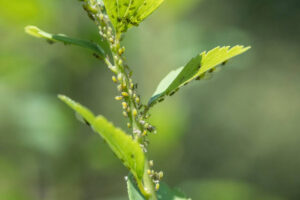
If you notice any of these symptoms on your plants:
- Leaves have dark green patches with yellow or black specks.
- White cottony masses that look like small balls of fluff or fur on the undersides of leaves or stems.
- Check for honeydew, a sugary substance produced by thrips as they feed on plant sap. Honeydew also attracts ants which may then spread disease to your plants.
- Leaves are pale green with yellow or black specks (mottling).
- Leaves have holes caused by sucking insects, such as aphids.
- Look for clusters of small, clear-colored insects near your plants’ stems. They are often clustered together and may move around quickly at first glance.
Thrips and Aphids damage
Thrips and aphids are both plant pests. They’re both insects that feed on plants but do so differently.
Unlike aphids, thrips do not suck sap from the plant. Instead, they feed on the leaves of plants by piercing them with needle-like mouthparts that inject saliva into the tissue. The saliva contains a sugary substance vital to their survival, so it doesn’t matter how much damage they do to their host plant; you can still harvest it.
Aphids are also known as plant lice because they feed on plants by sucking sap directly from the leaves upper surface. However, unlike thrips and other insects that feed on more than one plant, aphids only eat one plant at a time: plants in the mustard family (i.e., cabbage family).
Thrips and aphids damage plants by causing leaves to turn yellow and die. Stunting or growth reduction is the most common symptom of thrips and aphid damage.
However, in most cases, thrips may cause little to no visible damage, but they can still make a huge impact on your soil and plants.
Below are the damages caused by thrips and aphids
- Affecting the growth of a plant
- Affecting the appearance of a plant
- Damaging the quality of a plant’s flowers or fruits
- Causing plants to lose their leaves or entire branches
- They can cause leaf yellowing, browning, and curling up.
- They can cause stunted or reduced new plant growth due to feeding.
Best pesticide for thrips and aphids
BioAdvancedRose & Flower Insect Killer RTU

Chemical killing of insects is getting harder and harder because the bugs are finding ways to adapt to it. BioAdvanced Rose & Flower Insect Killer is a pesticide that eliminates aphids, whiteflies, beetles, fleas, roaches, ants, and more without harming beneficial garden insects such as ladybugs and spiders. It is formulated for use around newly planted gardens, in containers, and on ornamental plants.
This insect killer comes in a convenient, easy-to-use concentrate with color-coded spray bottles – plus a plastic applicator wand to help you target insect problems in plants. Ingredients include a patented active ingredient that targets specific pests when used as directed.
Safer Insect Killing Soap Concentrate
This insecticide soap is for you if you have trouble with pests such as aphids, thrips, fruit flies, weevils, and more on your garden plants. Safer Insect Killing Soap Concentrate kills over 50 pests and is safe for most plants and crops.

The active ingredient, Pyrethrins, attacks and kills insects upon contact, preventing them from mating by interfering with the transmitter nerves that control reproduction.
This non-staining formula also has anti-fungal properties to inhibit the growth of mold, mildew, and bacteria such as stinkbugs. Safer 5118-6 Insect Killing Soap Concentrate can be used in traditional and Integrated Pest Management (IPM) programs to control aphids, whiteflies, spider mites, and mealybugs on all types of fruit, vegetable, and ornamental plants, including flowers.
Bonide Captain Jack’s Dead Bug Brew Ready to Use Insecticide

Captain Jack’s Dead Bug Brew Ready-to-Use Insecticide has a fast-acting, residual formulation that provides up to 6 months of control for many common pests like aphids, Japanese beetles, and mosquitoes. It kills with one application and is highly recommended by professional pest control professionals.
This product is the first pesticide that dead bugs can’t stand. With a powerful blend of oils, it completely binds with pests and prevents them from walking away. You’ll have peace of mind knowing that your garden is fully protected. BND250 is also ideal for hydroponic growing systems as it will not affect the nutrient solution.
How to get rid of thrips and aphids
Use sticky traps
You can buy them at any grocery store or hardware store; they usually come in packs and are affordable. Just place it on the underside of a leaf or flower petal where you see the problem (you might have to experiment a bit to find out where). The sticky glue kills off the pests by causing them to stick to it; as they try to eat it off the plant, they’ll eventually die from starvation or dehydration when they can no longer reach their food source.
Try companion planting
Companion planting is one of the easiest ways to eliminate aphids and thrips. It involves planting a variety of plants in your garden that repel pests. Planting marigolds and nasturtiums near your vegetables will help repel aphids while planting mint near your tomatoes will help keep off thrips.
Use garlic spray
Garlic spray is an excellent way to get rid of pests such as aphids and thrips. The oil in the garlic will kill them off and keep them away from your plants. Garlic is your go-to if you’re looking for a quick way to clear up your plant problems.
Mix one teaspoon of garlic powder with two teaspoons of water in a spray bottle and shake until it’s evenly mixed. Spray the leaves of your plants and wait for them to dry. Then water your plants again to wash away any residue left by the spray.
Use insecticidal soap
Insecticidal soap is an effective way to get rid of thrips and aphids. Insecticidal soap kills off aphids and is effective against greenflies.
You can use insecticidal soap to prevent your plants from getting infested with aphids, but you will need to do this every month until your plants are free of aphids.
Follow these steps:
1. Mix 1 tablespoon of insecticidal soap with 1 gallon of water in a spray bottle.
2. Spray your plants with the solution to get rid of the aphids and thrips.
3. Repeat as needed until you no longer see any pests on your plants!
Use horticultural oils
Horticultural oils are made from plants so they won’t harm your plants or the environment. You can use them either on their own or mixed with other pesticides.
This will not only kill the insects on contact but also repel future generations, so you don’t have to worry about them returning. You can purchase these oils at most gardening stores or order them online if they are not locally available.
Apply horticultural oils around the base of the plant where it sits on the soil. You can also apply the oil around any other cracks or crevices that may be present in the potting soil or in the container itself.
Release Beneficial Insects.
If you want to get rid of thrips and aphids, you’ll need to release beneficial insects into the area. These insects will eat the pests and help repel them.
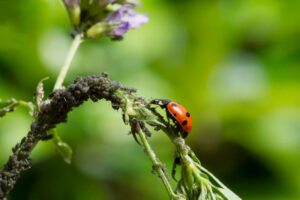
There are many types of beneficial insects that can help rid your garden of thrips and aphids. Some examples include ladybugs, lacewings, hoverflies, and parasitic wasps.
You can release beneficial insects into your garden by releasing them in the soil. They can be released into pots or containers on your patio or deck, but be careful not to let them fly away. You can also attract these insects by growing plants they love. Doing this will keep them in your garden and help reduce pest infestation.
Create a neem oil spray
Neem oil can be used as a pesticide to kill and repel aphids, thrips, and mealybug eggs. It also works well on other insects that are pests in your garden. It’s also safe for plants, so you don’t have to worry about harming your garden.
Mix ¼ cup neem oil with 1 gallon of water and spray all over your plants as needed. You can also add neem oil to your soil to help prevent pests from infesting your plants.
Spray your plants every 2 days for 3 weeks to get rid of the aphids and thrips. You can also spray the soil around your plants to kill the mealybug eggs.
Use spinosad sprays
Spinosad sprays are effective at killing off both the larvae and adult stages. They’re made from the fungus that grows on the seeds of the “thorny” plant (spinach). The spray will kill any insects that come in contact with it.
It works best when used as soon as possible after an infestation has begun, but it can also be used to prevent infestations from occurring by making sure to keep your plants healthy and well-watered.
This will kill the insects and their larvae, so they won’t reproduce anymore. You can also spray the soil around your plants with this chemical if it’s infested with aphids or thrips.
